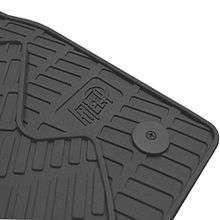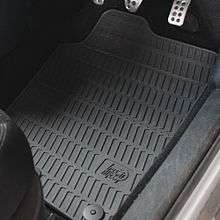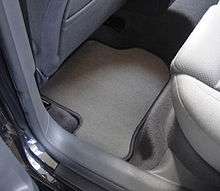Vehicle mat

Vehicle mats, also known as automobile floor mats, are designed to protect for the floor of a vehicle from dirt, wear and salt corrosion.
One major use of a vehicle mat is to keep the car looking clean. Most mats can be easily removed for cleaning and then replaced. Some require fixation points to ensure they remain fixed in position.
Overview

Vehicle mats are an interior car parts accessory that generally are included with the purchase of a vehicle, and are supplied by the selling company. However, with the surge in leasing organisations and sales through such channels, some cars are offered without them. Vehicle mats have been available for many years as an accessory product, though dealerships usually offer them with the purchase of a vehicle.
Vehicle floor mats come in a variety of shapes and materials. They may feature spikes, grooves or caps to capture dirt and water, and be made from the synthetic rubber (often referred to as "vinyl" or "thermoplastic") or textile materials. Floor mats should be distinguished from floor liners.[1]
Floor liners feature molded bottoms and edges that run along the walls of vehicle's foot wells. Floor mats,on the contrary, are flat on the bottom and are fitted between foot well walls.
Materials

Vehicle mats generally come in two options: either rubber or alternatively carpets. Carpet mats and rubber mats differ in a number of ways; each material provides advantages and disadvantages when compared to the other. For instance, Carpet mats are generally tufted and have a rubberised anti slip backing. On the other hand, rubber car mats are heavy duty and higher durability. While some car mats are the plain colour of rubber, many contain branded company logos, cartoon characters or even advertisements. Some are in textile form of carpet material. They can also come in a wide range of colours. The terms universal and custom fit mats differentiate between floor mats that will fit a multitude of different cars and those that are specifically designed to fit only one chassis.[2]
Some styles of mats may feature small, flexible spikes on their underside to grip carpeting underneath better.
Many makeshift vehicle mats are also becoming more popular, often taking the form of PVC alternatives, but rubber vehicle mats are still seen as the safest option. Another material growing in popularity is leather, which is also often found in seat covers, though it is usually more expensive.
Regulations
Car mats produced by original equipment manufacturers must follow stringent regulations in the US, especially due to recent Toyota car mat recalls over their safety. They are regulated to ensure manufacturer credibility and product specifications and quality. Factors in consideration include odour release, durability, performance in various heat levels, etc.
Safety systems are also becoming more and more common in rubber mats; for example an anti-slip bottom side and a heel pad for added safety and wear.
Market changes
Original equipment manufacturers are now starting to develop non-OEM channels for reduced customer cost and increased market.
Recalls
On September 26, 2007, Toyota recalled 55,000 sets of heavy-duty rubber floor mats from the Toyota Camry and ES 350 sedans.[3] The recalled mats were of the optional "all-weather" type. NHTSA stated that the recall was due to the risk that unsecured mats could move forward and trap the gas pedal.[3]
|
|
On August 28, 2009, a two-car collision killed four people riding in a Lexus dealer-provided loaner ES 350 in San Diego, California, due to the accident vehicle being wrongly fitted with all-weather rubber floor mats meant for the RX 400h SUV, and that these mats were not secured by either of the two retaining clips.[5] The brake hardware also showed signs of heavy braking consistent with a stuck accelerator pedal.[5] The report stated that the accelerator pedal's hinge did not allow relieving obstructions, and the dashboard lacked directions for the three-second emergency press of the push button keyless ignition. NHTSA investigators also recovered the accident vehicle's accelerator pedal, which was still "bonded" to the SUV floor mat.[5]
See also
- Mat
- Car boot liner
- Rubber mat
- 2009–2011 Toyota vehicle recalls
- n:Toyota accused of misleading public over recalls
References
- ↑ "What Are The Differences Between Floor Mats And Floor Liners?".
- ↑ "Keep Your Floors Looking Good With New BMW Floor Mats". StealthAuto. Retrieved 2 May 2013.
|first1=missing|last1=in Authors list (help) - 1 2 "Toyota Recalls Floor Mats – Car News". Caranddriver.com. Retrieved 2011-03-03.
- ↑ "Runaway Toyotas: Fact Or Fiction?". Autoblog.com.
- 1 2 3 Bensinger, Ken; Vartabedian, Ralph (2009-10-25). "New details in crash that prompted Toyota recall". Los Angeles Times. Retrieved 11 February 2011.
5. "Vehicle Floor Mat Compare WeatherTech vs Husky Liner", Gillian Parsley